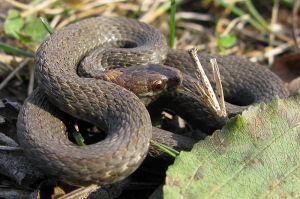 Sometimes we long to be with nature. When we’re camping, hiking, paddling, birding- one of the reasons to do so is to see and experience the other forms of life that are all around us. Other times, we strive to remove ourselves and are happy at the apparent absence of our fellow creatures (cellar spiders are one species in our house that I would be happy to get along without). But try as we may, at best we can only slow the efforts of others to enjoy the comforts of our homes. In ecological terms, our houses represent an underutilized niche that has the capacity to support more than just humans, and nature relentlessly strive to fill that void.
Sometimes we long to be with nature. When we’re camping, hiking, paddling, birding- one of the reasons to do so is to see and experience the other forms of life that are all around us. Other times, we strive to remove ourselves and are happy at the apparent absence of our fellow creatures (cellar spiders are one species in our house that I would be happy to get along without). But try as we may, at best we can only slow the efforts of others to enjoy the comforts of our homes. In ecological terms, our houses represent an underutilized niche that has the capacity to support more than just humans, and nature relentlessly strive to fill that void.
Like it or not, our homes are a part of the larger ecosystem around them. The interiors represent a very select habitat that can support only certain organisms. We like to be the ones to select our cohabitants- my house, with humans, a dog, two cats, a lizard, and fish is sometimes more an ecosystem that I would like, but we have invited these creatures in with us. Each year when the leaves fall, other animals seem to recognize the value of the warm, dry, inside space we make for ourselves. I haven’t found the spot or spots they enter, but white-footed mice, common in forests around here, seem to have no trouble making their way inside our old farmhouse. Deer mice, house mice, and meadow voles also seek shelter in homes. Our cats seem more content to watch and listen rather than catch, prompting us to create a trapline so that we can try to manage the rodent population. Perhaps the cats are smarter than I give them credit for, as they like to pick up the deceased mice, trap and all, and carry them around proudly as if they had in fact earned their keep.
Also seeking shelter in fall at the nature center are red-bellied snakes, which each year find a crack under a door for entry. These small (not much bigger than a nightcrawler), gray-brown creatures with orange undersides are gentle and almost never attempt to bite when picked up to be placed back outdoors. To do so is best, as our homes are probably too warm and dry for them to survive the winter.
And then there are our permanent cohabitants- invertebrates like cellar spiders (which look like daddy long-legs), silverfish, and their predators like pseudoscorpions and house centipedes. A large specimen of the latter surprised our staff a few days ago. House centipedes were originally from the Mediterranean region but traveled with people to Europe and America. They can live for years, taking three years to mature. These creatures ultimately use energy we provide in the form of crumbs and dust we leave behind. Their lives are parallel to ours mostly- spiders building webs in corners to catch unwary insects that enter our homes, silverfish and their predators- exist mostly unnoticed by us. Creatures like mice and cockroaches, if one is unlucky enough to host them, can transmit disease from place to place and certainly need to be managed, but a lot of that can be done my reducing their food sources.
As our dwellings age, their indoor ecosystems probably mature also. Cracks open up to the outside, dust accumulates in unnoticed places, and surely some living thing will find a way to benefit from those. Although we don’t like to think about, nature is all around us whether we are indoors or out, and on and inside us for that matter. It’s not a bad thing- it may be that exposure to a lot of different creatures helps our immune systems tune themselves to our environment, helping to keep us healthy. At least, if we can remain objective about it, the realization of these intimate associations between worlds is fascinating.
